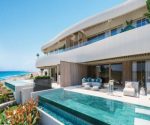Going circular – the rise of the dome house
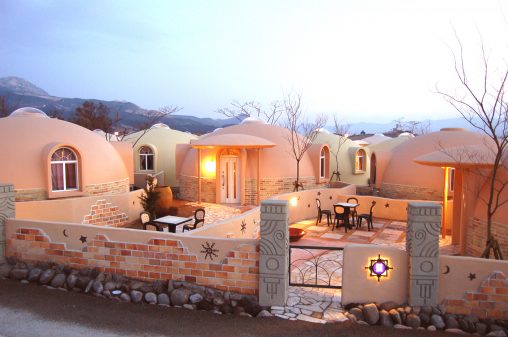
From Japan to the USA and the Alps, round ‘domed’ homes are a hot new trend in architectural design. Besides fitting right into a new paradigm of construction and sustainability, they offer a fresh perspective on living, vacationing and even working that is taking the world by storm and coming to our shores as well.
We tend to think of our homes as being rectangular, or at the very least a combination of right-angled elements, but the earliest homes were all round. Increasingly, new designs are showing just how beneficial that can be, from optimal temperature maintenance and energy efficiency to better resistance in extreme weather conditions. As a result, a whole new generation of round homes is emerging to suit a wide range of needs worldwide.
Japanese Custom Dome House
Japan’s high density living means it has always been advanced when it comes to developing compact housing solutions. In fact, you could call it the global micro-house expert, and successful experiments with prefabricated and even cardboard homes prove it. The latest development in micro housing to come out of the Land of the Rising Sun is the Dome House, which optimises economies, construction time and space to offer comfort and homeliness in small homes, holiday accommodation and even business premises.
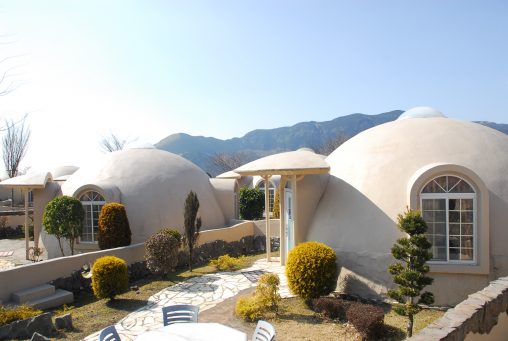
The innovative system makes it possible to quickly and economically produce a range of round-shaped structures from prefabricated ‘expanded’ polystyrene components. When placed together, they can produce a variety of shapes varying from circular to arch and extended dome structures, which can be used for anything from homes and cabin suites to offices and even warehousing. Hugely popular in Japan, where they have above all been a hit in holiday parks, these versatile homes are cheap, easy to build, practical and fun, with excellent thermal qualities and a high level of comfort.
Off-grid Hemp House
In the search for alternative, sustainable building materials, German architect Monika Brümmer with an international team formed by Adrar Nouh cooperative, ENAT, ENSA (from Morocco) and Fraunhofer CSP (from Germany), has created an ultra-efficient dome house made from hemp. In fact, the property is off-grid and powered entirely by solar panels, which form part of the architecture and structure. The prototype, called SUNIMPLANT, was built by students in Morocco and entered in the ‘Solar Decathlon’, a competition organised by the Moroccan Research Institute for Solar Energy IRESEN, UM6P, the Moroccan Ministry of Energy and Environment and the US Department of Energy.
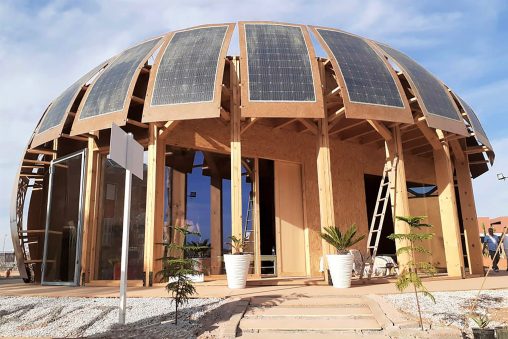
Made entirely from locally produced raw materials such as hemp fibre composites, vegetable bio-resins, hemp-concretes and other local non-synthetic materials, the Hemp House is entirely natural and renewable, as well as economical and energy-independent, so very cheap to run. “This ‘spaceship’ is advanced in time and reflects a turn not only in North Africa but in hemp construction, which doesn’t have comparable prototypes anywhere in the world,” said hemp building expert Monika. In 2017 she co-founded the Rifian cooperative Adrar Nouh whose mission it is to build sustainable hemp housing in Morocco’s underprivileged High Riff region for the stimulation of rural African green economies.
www.cannabric.com
www.sunimplant.com
Environmentally sustainable housing could be commonplace in our lifetime.
Posted by Waking Times on Sunday, May 24, 2020
Mandala Homes
The custom-built homes of Mandala also use natural local resources and rounded architecture to produce a very vernacular, practical and environmentally sound kind of housing solution. Being based in British Columbia, Canada, that natural resource is wood, and Mandala will add elements or combinations of dome segments to create comfortable, spacious and stylish homes that blend in beautifully with their Canadian Rockies surroundings.
It’s the ideal country property or holiday getaway, featuring appealing looks, first-class energy and environmental credentials, including the region’s first-ever Energy Star Rating in 2011, and comes with panoramic bay windows, double-height living spaces and porches – all made to measure.
Natural Spaces Domes
Take the concept a little further into the sci-fi sphere and you come to these avant-garde structures created by Dennis Odin Johnson and the team at Natural Spaces Domes. He has been a sustainable construction pioneer since the 1970s, concluding that the Geodesic structure originally conceived by American architect Buckminster Fuller is the most efficient of all home types. Based on classic geometrical principles, the triangular sections come together to form the most effective housing structure ever. Not only are they strong, practical and easy to construct, but they use less building materials, are lighter and also super-efficient when it comes to energy consumption.
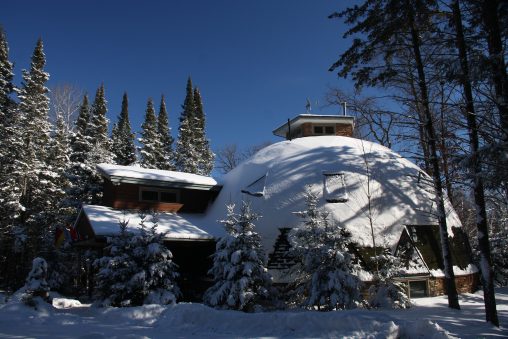
Already used in greatly varying sizes as greenhouses, research centres and even homes in different parts of the world, these low CO2-producing structures are taking off as a new generation learns of their advantages. Moreover, they can have a broad range of cladding to produce different architectural looks and finishes, are easy to maintain a pleasant temperature and can be built economically on a very wide range of scales. Natural Spaces Domes specialises in creating affordable, sustainable homes that are also very comfortable and attractive, and for many the house of the future.
Whitepod Eco-Luxury Hotel
The Whitepod Hotel in the beautiful alpine setting of Valais, in Switzerland, is a fine example of dome structures used as luxury accommodation. Perfect for the prevailing conditions, the pods are distributed around to form a very private and spacious form of independent suite accommodation surrounded by gorgeous nature. The pods and eco-chalets of the Whitepod Hotel offer a highly environmentally friendly way of enjoying luxury amid spectacular views in ultimate hiking country.
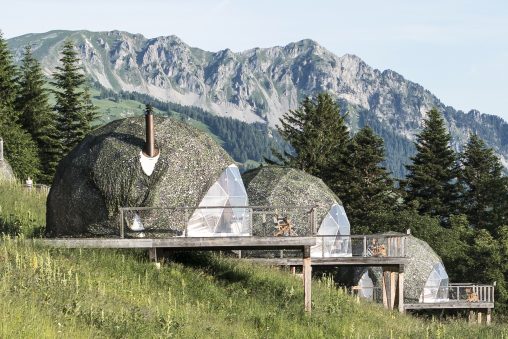
They prove just how high-tech, comfortable and stylish a structure of this kind can be, in this case in the form of private suites with full amenities yet not not attached to a main hotel building. It’s a new concept in tourism, and one that suits natural destinations but also straddles the line between glamping and conventional hotel accommodation.
The Bitcoin Villa
Up to now, the focus of circular homes has been largely on a micro level, but the Bitcoin House created by US entrepreneur and owner of NextGen, an architectural firm, Jean-Pierre D’Zahr, is a different proposition altogether. A former developer and designer at Microsoft and Boeing corporations, he comes from a financial and technical background, and applies his knowledge to the superbly luxurious modern villas he has been designing in the USA and now introducing to Europe and the Middle East.
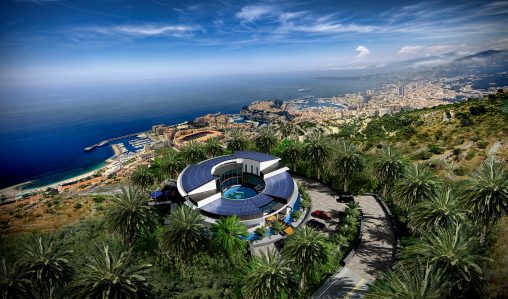
“There’s an architectural innovation vision that drives me,” says Mr. D’Zahr, who didn’t follow in his father’s footsteps to become an architect but pursued his passion for home design later in his career, and now owns and operates an architectural design firm since 2015, creating luxury 21st century villas. In this he works closely with like-minded visionary architects, technicians and builders to realise his dream-home concepts, designs and the creation of the pioneering Blockchain Mortgage.
Once the concept was in place, NextGen had a very unique and revolutionary model ready to be implemented. Here is a modern home brimming with cutting edge design and technology that embodies the luxury of a 21st century villa, offering the highest levels of refinement and comfort, combined with top energy consumption and environmental credentials. It wasn’t long before his villas drew attention, eventually leading to a business specialised in creating bespoke new architectural design projects, such as the magnificent All-Star Dream Home.
A unique concept comes to Europe – and Marbella
The range of villas has expanded in terms of the available sizes, configurations and features, but typical of a home of this standing is the exceptional level of design and engineering, which includes water features integrated over three layers in the form of ponds, sheet waterfalls, spas and indoor and outdoor swimming pools. A fine example is the Cantilever Villa, whose imposing fountains provide a visual spectacle as you enter the property. The large, double-height and open-plan living areas enjoy panoramic windows that adapt to the amount of sunlight entering through them, thus keeping the temperature constant and doing away with the need for curtains and shades.
As you can imagine, kitchens, bathrooms, private suites, spas, gymnasiums, entertainment areas and even garages are taken to another level of luxury, while the terrace becomes a glamorous extension of the living room when the doors glide open and the pool areas appear to come into the house. One of the spectacular features of the Cantilever Villa is indeed the swimming pool, the purest example of an infinity pool as it juts out from the main house and actually floats in mid-air.
Why it’s called the Bitcoin House
Along with targeted locations like the USA, Dubai, and the Caribbean, Mr. D’Zahr is now bringing the concept to Europe, setting up base in Monaco and Nice, while also launching in Spain. “The Bitcoin House is perfectly suited to the Marbella market, with its cosmopolitan high net worth clientele and upmarket lifestyle.” In the EU, these architectural marvels range from €50 million to €200 million (land not included) but come with a revolutionary way of thinking that, according to many, will change the way we own homes. “It’s a top-down process, starting with ultra-luxury villas like this, but one day the technology will extend the concept to the broader market too.”
With its unique design and self-sustainability, the Bitcoin House model allows for privacy and multiuse, and it can function as a healing sanctuary, resort, retreat, medical clinic or a high-end vacation rental. Owners only pay 20% of the sum down and get an accelerated mortgage for the remainder. This is not the unusual part; the fact that the property is self-financing is where the Bitcoin villa is unique, for with each property comes a Bitcoin mining facility located in a low-tax domicile. Its cost is incorporated in the price and it consists of the powerful computing capacity that underlies Bitcoin Mining, and for which ‘miners’ receive Bitcoin remuneration. “Normally, the system uses so much energy that it is prohibitive, but we’ve partnered in the development of Electromagnetic generators that produce their own renewable energy 100% off-grid at a cost of 1 cent per kWh US, putting us in the profit zone.”
The renewable energy station that comes with the Bitcoin House produces a total of 6.5 MWs, of which 6 MWs is used up by the fully turnkey mining operation and the remaining energy .5 MWs is installed and delivered at the 2,440m2 luxury Bitcoin House – with the possibility of selling any electricity not used back to energy suppliers, if the homeowner chooses to do so. “The monthly income from the Bitcoin mining operation is estimated at $1.5+ million per month – at the current Bitcoin value of $9,000 per Bitcoin – more than covering the $892,000 mortgage.
The innovation in the Blockchain/Bitcoin Mortgage in simple terms is that the 30-year mortgage is paid off at an accelerated rate. The home buyer pays a 20% down payment and never has a mortgage payment, as the earning from the Bitcoin mining operations pays the monthly mortgage for the homeowner. In fact, if the earnings exceed the mortgage by $200k, NextGen has calculated a bonus to the homeowner with a $100k per month payment to live in the home, making this the first income generating home of its kind in the world. If Bitcoin goes up in value, the extra income earned goes towards paying off the mortgage faster.
This new way of thinking is a true paradigm shift in home ownership, combining the latest developments in technology, architecture and finance. “The world is changing, and so is the way we are doing things. We’re in a stage of evolution in which old concepts are being replaced by new ones, and while a lot of people fear some of these, there is an opportunity to change many things for the better. This system is not just unique but it is also a financially sustainable model that effectively makes your luxury villa a productive economic unit that pays for itself, and much more.”
First published in Essential Magazine
Images Courtesy of: Japanese Custom Dome House, Cannabric, Natural Spaces Domes, Whitepod Hotel, Next Gen Living Homes


